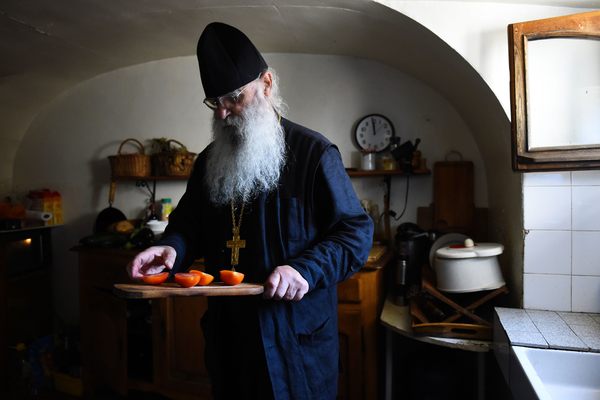About
A visit to the Alaverdi Monastery, standing tall and solitary amidst the stunning Greater Caucasus Mountains, feels like stepping into paradise. Set against the backdrop of a tidal wave of clouds in an azure Georgian sky, this monastery was founded in the 6th century by an Assyrian monk named Joseph Alaverdeli. The current cathedral—of Georgian Orthodox denomination—was built in the 11th century by King Kvirike, ruler of the Kakheti region.
From a distance, the monastery looks austere, like a fortress. Inside, the sprawling grounds have their own vineyards, growing over a hundred grape varietals; stone steps lead to open courtyards; monumental arches and high ceilings reveal ancient inscriptions and nearly-fading frescoes of the Virgin and holy child.
Most visitors come to Alaverdi less for the divine than the Dionysian. Here, at the monastery’s marani, or wine cellar, monks have been making wine the way it’s been made in Georgia for over 8,000 years, in giant clay pots buried in the ground, called qvevri.
The monks like to say that the heady fragrance of the wine emanates from these clay pots through the monastery’s compound. The original 11th century qvevri, aged and cracking at the mouth, is still on display. At the time, the monastery was making between 2,000 and 4,000 liters of wine annually. It is unclear when wine production at Alaverdi stopped, but after archeological remains of the original qvevris were dug up, the cellar was slowly restored and winemaking began anew in 2006. The five monks working at the marani have produced hundreds of thousands of bottles of wine since.
The traditional wooden press where winemakers crushed grapes with their feet still stands at the marani. It looks a bit like a dugout canoe, and is made from the trunk of an entire tree. The famous Georgian amber-colored wines are made by putting crushed grapes, skin and all, into the qvevri pots, and leaving them to ferment naturally, a process that takes six months. The pots are sealed with fresh clay, then covered with sand and stones, so no moisture gets in. Several brick circles on the polished stone floor of the cellar mark the spots where the qvevris have been buried. When the monks open the qvevri after six months (usually in the spring), the mushy grape sediment has sunk to the bottom. These days, the monastery cellar also makes wines in steel tanks and oak barrels.
The qvevri-made wines are highly tannic, due to contact with the grape skins. They tend to have a nuttiness, with top notes of apricot and peach, and an earthy aroma akin to a hike through a forest. They are bottled with the signature label of the cellar, all of them stating “since 1011,” the year the first wines were made. The monks like to say that the ideal timeline of wine enjoyment is to make it when a child is born and drink it when the child gets married.
Related Tags
Know Before You Go
The monastery organizes daily wine tours, which must be booked in advance.
Community Contributors
Added By
Published
May 10, 2019
Sources
- https://www.youtube.com/watch?v=losNFIkwVYQ
- https://whc.unesco.org/en/tentativelists/5221/
- https://www.youtube.com/watch?v=-b-BWueN9ts
- http://since1011.com/en/about-us.html
- https://www.winesgeorgia.com/site/domaine/alaverdi-monastery-marani
- https://www.euronews.com/2015/06/22/kakheti-georgia-s-cradle-of-wine


























































